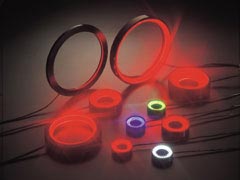
Posted to News on 23rd Aug 2010, 16:44
How to select the best illumination method for machine vision
This article from Stemmer Imaging discusses the critical issue of illumination for machine vision applications.

In any machine vision application, the illumination is a critical part of the system for producing an image of the features or faults with sufficient contrast for evaluation using the image processing software. Different effects can be achieved by altering the orientation, geometry or colour of the illuminating light.
Light sources
There are various types of illumination commonly used in vision applications:
- Halogen
- Incandescent
- Fluorescent
- LED
- Laser
Each type has its merits but, increasingly, LEDs have become the illumination method of choice for practically all vision applications. They produce a high light intensity at a relatively low cost and have a long service life of up to 50,000 hours. LEDs are available in single-wavelength and white light versions. In addition to the visible spectrum, both UV (ultraviolet) and infra-red (IR) light can play a major role in revealing specific features on or in the object to be inspected.
Lighting geometry
The way the light strikes the target determines how it will appear to the camera, with the direction of light enabling different features to be highlighted. The angle of incidence is determined by the plane of the camera: back lighting sources illuminate the object from the opposite side to the camera; bright field illumination illuminates the object from the same side as the camera, with the light source within the field of view of the camera as reflected in the surface under examination; and dark field illumination illuminates the object from the same side as the camera, but with the light source positioned outside the field of view of the camera.
Choosing different illumination methods can give significantly different images of the same object (see movie above). The surface of the object is also of paramount importance, since there is a vast difference between a shiny mirror-like surface and a matt surface.
Quality of light
The 'quality' of light refers to whether the light is diffuse or not or, for lasers, whether it is coherent. Diffuse light is most useful for imaging shiny surfaces, otherwise the illumination source may be visible in the reflection. For particularly shiny materials it may be useful to use diffuse on-axis illumination, where the light is introduced along the optical axis of the camera. In irregular shiny surfaces (such as foils) it is necessary to use diffuse illumination from a large angle to avoid bright and dark areas. This is traditionally done with dome lighting. An alternative to diffuse light is structured light, which is collimated or made parallel. This is useful for back lighting, where a clear silhouette can be obtained, whereas non-collimated back lights create reflections around the edges of targets and give less clear edges. In addition, collimated bright-field front-lighting allows surface defects to be clearly visible. A flat surface reflects the light, but any part of the surface that is not flat will reflect the light away from the camera, showing defects as dark areas.
Lighting control
Illumination generally needs to be controlled in some way. Lights can be strobed or pulsed, the intensity can be raised or lowered or, in a more complex setup, different lighting scenarios can be pre-programmed using a lighting controller. This allows for multiple illumination setups to be used in sequence.
More information
Considerably more information about lighting for machine vision and image processing applications is available within the free 2010/2011 edition of the Imaging and Vision Handbook, which is published by Stemmer Imaging. In addition, helpful advice is contained in Stemmer Imaging's free Imaging Selection Guide document, A Summary of Illumination Techniques, which is available to download from the illumination section of the website.






























